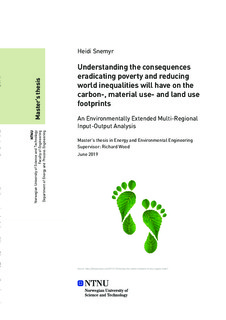| dc.description.abstract | Menneskeskapte klimagassutslipp har de siste tiårene resultert i permanente skader på klimaet, noe som både vil påvirke denne og fremtidige generasjoner. Jordens gjennomsnittstemperatur har allerede steget med én grad siden preindustrielle tider - og stigningen vil fortsette dersom det ikke iverksettes radikale tiltak for å redusere dagens nivåer av klimagassutslipp. Som et globalt svar på klimautfordringene, ble bærekraftsmålene i 2016 signert av De Forente Nasjoners medlemsland. Ambisjonen er at målene skal bidra til å sikre en bærekraftig utvikling hvor både sosiale, økonomiske og miljømessige problemer blir adressert gjennom et sett med retningslinjer. Til tross for et stort, globalt fokus på bærekraftsmålene, er det gjort lite forskning på samspillet mellom disse målene, og om det vil finnes tilfeller hvor arbeid for å nå et mål kan ha negative effekter på andre mål.
Denne oppgaven kartlegger samspillet mellom tre av bærekraftsmålene; å utrydde fattigdom (mål 1), å redusere ulikheter (mål 10) og å motvirke klimaendringer (mål 13). Målet med denne oppgaven er å få en bedre forståelse av miljøkonsekvensene fattigdomsbekjempelse og reduksjon av ulikheter kan gi, i tillegg til hvilke tiltak som må iverksettes for å redusere disse konsekvensene. Følgelig blir tre ulike hovedscenarier utforsket: ett hvor fattigdom er utryddet, ett hvor ulikheter innad i land er redusert, og ett siste hvor ulikheter mellom land er redusert. Det blir brukt en flerregional kryssløpsanalyse (MRIO) for å studere konsekvensene scenariene vil ha på tre klimaavtrykk; karbonavtrykk, arealbruk og materielt bruk. Det blir i tillegg utført regresjonsanalyser for å kartlegge korrelasjonene mellom de tre forskjellige klimapåvirkningene og BNP.
Resultatene tilsier at å redusere ulikheter ved å fordele det nåværende globale fotavtrykket likt mellom alle, og dermed også utrydde fattigdom, vil føre til et fortsatt lite bærekraftig forbruk, noe som gjør det vanskelig å samtidig oppfylle de tre bærekraftsmålene per dags dato. Det er videre konkludert at å oppfylle de tre målene kan være mulig dersom de rikeste reduserer sitt forbruk i stor grad. Dette impliserer at de rikeste forbrukerne har det største ansvaret for å redusere de globale fotavtrykkene ved å redusere sitt eget overforbruk. Å finne måter å realisere en reduksjon i overforbruk kan være problematisk da dette vil kreve forbedrede politiske tiltak og endringer i forbrukeratferd spesielt rettet mot de rikeste, noe som potensielt kan bli møtt med stor motstand fra de rike. | |
| dc.description.abstract | The anthropogenic greenhouse gas emissions over the last decades have made irreversible impacts on the Earth’s climate system, which will affect both current inhabitants and future generations. The average global temperature has already seen a one-degree Celsius increase since the pre-industrial times and will continue to rise if no radical changes are made on the current exploitation of the Earth’s resources and capacity. As a global response to the environmental challenges, The Sustainable Development Goals (SDGs) were developed by the United Nations and agreed upon by the member states in 2016. The Goals are meant as a guideline for all countries to ensure a sustainable development, where social, economic and environmental issues are addressed. Nevertheless, the interactions of the Goals and whether these would potentially nullify each other is a field of study where there currently are substantial knowledge gaps.
In thesis, the potential interactions between three of the SDGs will be investigated; eradicating poverty (goal 1), reducing inequalities (goal 10), and mitigating climate change (goal 13). The aim of this thesis is to better understand how eradicating poverty and reducing inter- and intra-country inequalities will affect the environment, and what policy measures that are needed to reduce the possible consequences. Accordingly, three main what-if scenarios are set up: where poverty is eradicated, inter-country inequalities are reduced, and intra-country inequalities are reduced. For each scenario the changes in carbon-, material use- and land use footprint are calculated. The scenarios are run by using an environmentally extended MRIO analysis, and further, regression analyses are conducted to analyze the correlation between the footprints and GDP, followed by a discussion of the possible policy impacts these scenarios may entail.
The results show that reducing inequalities by redistributing the current footprints equally amongst all, and thus also eradicating poverty, will still make the per capita footprint levels unsustainable. This implies that it is impossible to meet the three SDGs simultaneously with the current global consumption level. Nevertheless, it is concluded that reaching the three SDGs simultaneously might be possible with a large reduction in the consumption level of the richest. Thus, implying that the richest carry the main responsibility in reducing the global footprints to a sustainable level by minimizing their own consumption. However, finding ways to realize a reduction in over-consumption may prove problematic as it will require both policy measures and consumption regulation specifically targeting the rich, which may be met with resistance by the targeted. | |
